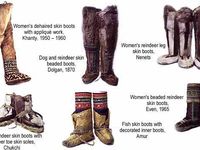Clothing in the Paleolithic Age represents a significant evolutionary milestone, manifesting human ingenuity and adaptability. During this time, survival hinged on the capacity to withstand diverse environmental challenges. If one were to ponder the question—how did early humans meet the challenge of climate variation and predation through their garments?—a complex interplay of culture, necessity, and innovation emerges. This exploration not only highlights the practical aspects of clothing but also reflects the cultural relativism inherent in our understanding of early human life.
The Paleolithic period, spanning from approximately 2.6 million to 10,000 years ago, was characterized by a hunter-gatherer lifestyle. Survival was paramount, dictating the choices made in clothing design and raw material selection. Clothing during this epoch served multiple purposes: protection from the elements, camouflage from predators, and even social signaling within groups. It is paramount to view these developments not simply as utilitarian, but as culturally imbued artifacts that illustrate the ethos of early human societies.
Initially, the modes of clothing were rudimentary, often fabricated from animal hides, plant fibers, and even woven grasses. The selection of materials reveals an early understanding of the characteristics necessary for survival. Animal skins provided insulation against cold climates, while lighter fabrics might have suited more temperate zones. This prompts the contemplation of knowledge transfer: how did early humans share techniques for garment creation across disparate geographic locales?
Moreover, the methods employed in crafting clothing also merit discussion. Through the utilization of rudimentary tools—such as sharp stones for cutting and needles fashioned from bone—early humans demonstrated a sophisticated engagement with their environment. Such ingenuity suggests a degree of cultural transmission. As communities evolved, so too did their approaches to clothing, integrating techniques and materials that were locally available, thus reinforcing the notion of cultural relativism wherein clothing is viewed through the lens of utility, aesthetics, and social norms specific to a group.
The aesthetic dimensions of Paleolithic clothing cannot be overlooked. While primarily functional, garments may have also served as a means of personal expression within social frameworks. Finds suggest that early humans adorned themselves with accessories—such as jewelry made from shells, bones, and stones. The presence of such artifacts invites a compelling question: did these embellishments reflect status, spiritual beliefs, or communal identity? Understanding clothing from this anthropological vantage point allows for a richer appreciation of human complexity during this formative period.
This inquiry leads to considerations of the social roles that clothing played. Evidence from archaeological sites indicates that clothing may have been differentiated by gender roles, with certain styles or methods of adornment predominantly associated with men or women. This introduces the consideration of how early human societies constructed gender, and whether clothing served as a medium for reinforcing or challenging these roles. To what extent did clothing define societal expectations versus allowing for individual expression?
Furthermore, the geographic diversity during the Paleolithic period contributed to variability in clothing practices. Communities adapted to arctic, temperate, and tropical climates each developed distinct survival strategies manifest in their clothing design. For instance, the use of fur in colder regions contrasted sharply with the use of leaves and lightweight fibers in warmer climates. This geographic variation presents an avenue for broader discussion about how localized environmental factors influenced cultural practices—one cannot separate the development of clothing from the landscapes that shaped human existence.
The implications of innovation in clothing within the context of survival also suggest ethical inquiries into the relationships humans forged with their environment. As hunter-gatherers delved deeper into the natural resources around them, a reciprocal relationship likely developed. The act of sourcing materials for clothing was intertwined with notions of reverence and respect for the living world. Thus, this relationship may challenge contemporary understandings of resource utilization, leading to the question: how can modern societies learn from the sustainable practices of Paleolithic tribes?
As Paleolithic cultures evolved from nomadic to more settled lifestyles, this shift invariably impacted clothing and textile practices. With the advent of agriculture and permanent settlements, clothing began to reflect not only personal identity but also a burgeoning societal complexity. The introduction of weaving techniques marked a pivotal point in garment creation, paving the way for the intricate textiles observed in later epochs. This transition emphasizes a crucial aspect of cultural relativism—each phase of human development brings about new paradigms of thought and practice, necessitating an appreciation for the continuum of human ingenuity.
Ultimately, clothing in the Paleolithic Age exemplifies a synthesis of function, culture, and identity. It invites ongoing examination into the ways early humans adapted their practices to survive in various ecological niches. The interplay of technological advancement, societal roles, and resource management deserves acknowledgment as a foundation upon which modern practices can build. Contextualizing early human innovation through the lens of cultural relativism facilitates a deeper understanding of how clothing—while seemingly trivial—can illuminate the broader complexities of human experience. As we continue to explore this remarkable epoch, the challenge remains: how do we honor and learn from the narratives woven into the fabric of our collective past?
